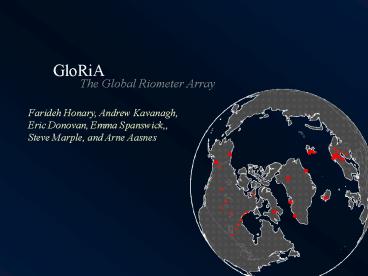Substorm Associated Spikes in HighEnergy Particle Precipitation - PowerPoint PPT Presentation
1 / 18
Title: Substorm Associated Spikes in HighEnergy Particle Precipitation
1
GloRiA
The Global Riometer Array
Farideh Honary, Andrew Kavanagh, Eric Donovan,
Emma Spanswick,, Steve Marple, and Arne Aasnes
2
GloRiA
The Global Riometer Array
The objective of GloRiA is to combine riometer
data sets from around the world creating a
virtual array which can produce images of
high-energy electron precipitation on a global
scale.
GloRiA incorporates riometer data from programs
in the UK, Finland, Canada, US, Germany, Denmark,
Japan, Russia, Australia, South Africa, Italy,
Norway and China.
3
GloRiA
The Global Riometer Array
The objective of GloRiA is to combine riometer
data sets from around the world creating a
virtual array which can produce images of
high-energy electron precipitation on a global
scale.
A virtual observatory (GAIA) is being developed
for easy access to summary optical and riometer
data. The first stage went online in September
2005.
4
Global Auroral Imaging Access
http//gaia-vxo.org
5
High-Energy Particles Sources
High-Energy Particle Measurements
(gt10keV)
In situ
Particle detectors (LANL, GOES, CRRES,
etc.) X-Ray Imagers (PIXIE)
Remote Space
Remote Ground-Based
Riometers (NORSTAR, SGO, IRIS, etc.)
6
High-Energy Particles Sources
High-Energy Particle Measurements
(gt10keV)
In situ
Particle detectors (LANL, GOES, CRRES,
etc.) X-Ray Imagers (PIXIE)
Remote Space
Remote Ground-Based
Riometers (NORSTAR, SGO, IRIS, etc.)
7
Riometer Measurements
Riometer Absorption
Baker et al. 1981
gt30 keV Electron Flux (geosynchronous)
- nearly continuously correlated data sets
(riometer and geostationary electron
measurements)
Remote sensing magnetospheric high-energy
electrons one objective of what we are doing
others are high-energy solar protons, structured
higher-energy aurora, etc.
8
GloRiA
The Global Riometer Array
Global images that are very coarse grained
spatially, but with high time resolution,
continuous coverage, and in regions very high
spatial resolution.
9
GloRiA
GloRiA Scientific objectives are
- Understand mesospheric chemistry changes due to
energetic particle precipitation and X-ray
flares. - Investigate the role of energetic particle
precipitation on the global atmospheric
electrical circuit. - Determine energy deposition into the mesosphere
via energetic particles and their modulation by
ULF waves on global scales. - Investigate the role of energetic solar particles
in stratospheric/mesospheric ozone destruction. - Provide a direct measure of the morphology of
precipitation - Monitoring absorption drifts.
- Producing large scale maps of absorption
including Inter-hemispheric and day/night side
examination of precipitation.
10
Riometer Measurements
Scale Sizes
The high-energy electron and proton precipitation
is organized on local and global scales and over
short and longer time scales.
11
(No Transcript)
12
Riometer Measurements
Scale Sizes
For example - PCA during the Bastille Day
Storm. Data provided by Gloria members CANOPAS
(NORSTAR), SGO, Univ.of Maryland and Lancaster
13
Riometer Measurements
Scale Sizes
For example the substorm onset CNA spike that
is possibly the fastest substorm onset signature
(Spanswick et al., 2005).
14
Scale Sizes
For example the global evolution of the
injection.
15
Substorm Injections
16
Substorm Injections
Drifting Electron Clouds
17
(No Transcript)
18
Conclusions
- GloRiA is an attempt to organize riometer
observations and data to provide researchers with
ready access to truly global network. - We are currently working primarily with data from
Finland and Canada, however GloRiA will involve
instruments operated by numerous other countries
in both hemispheres. - In September 2005 an initial phase virtual
observatory (GAIA) went online providing access
to summary data from some GloRiA stations. - There are a number of studies currently underway
(substorm spikes, dispersionless injections,
sawtooth events, ULF precipitation, etc) wherein
we are doing new science with data from this
useful instrument.































